Yosemite National Park, located in the central Sierra Nevada Mountains of California, is renowned for its awe-inspiring landscapes, diverse wildlife, and unique birdlife.
With its varied habitats, ranging from soaring granite cliffs and dense coniferous forests to babbling streams and lush meadows, Yosemite provides a haven for over 260 species of birds.
The diverse birdlife in Yosemite includes soaring hawks and eagles, colorful warblers, songbirds, and waterfowl, which make the park a paradise for bird enthusiasts and nature lovers alike.
In this article, we will explore the rich birdlife of Yosemite National Park, its habitats, and the unique birds that call it home.
1. Acorn Woodpecker
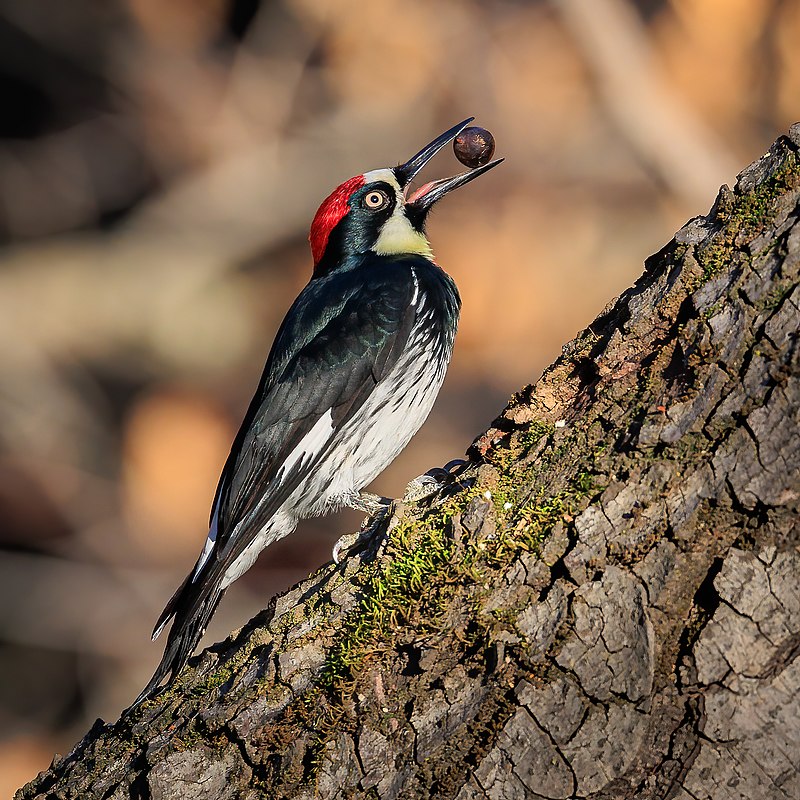
The Acorn woodpecker is a medium-sized bird with an average weight of 85 grams and 8.3 inches in length. It was first described by the English naturalist William John Swainson from a specimen collected in Mexico, back in 1827.
Its scientific name, Melanerpes formicivorus, combines Latin words meaning “ant” and “-vorous”.
This species has distinct black plumage all over its body except for some white patches on its wings and tail feathers which can be seen when flying or perched atop trees.
They are known to store acorns inside tree crevices as well as within bark cracks – often using them during lean times.
The acorn woodpecker is also socially active; they live together with other birds of their kind in groups called ‘granaries’. Their chirps are loud enough that they can easily be heard from afar.
Scientific classification:
| Kingdom | Animalia |
| Phylum | Chordata |
| Class | Aves |
| Order | Piciformes |
| Family | Picidae |
| Genus | Melanerpes |
| Species | M. formicivorus |
Also Featured In: Most Common United States Birds, Birds that Live in the Grand Canyon National Park
2. Lesser Goldfinch
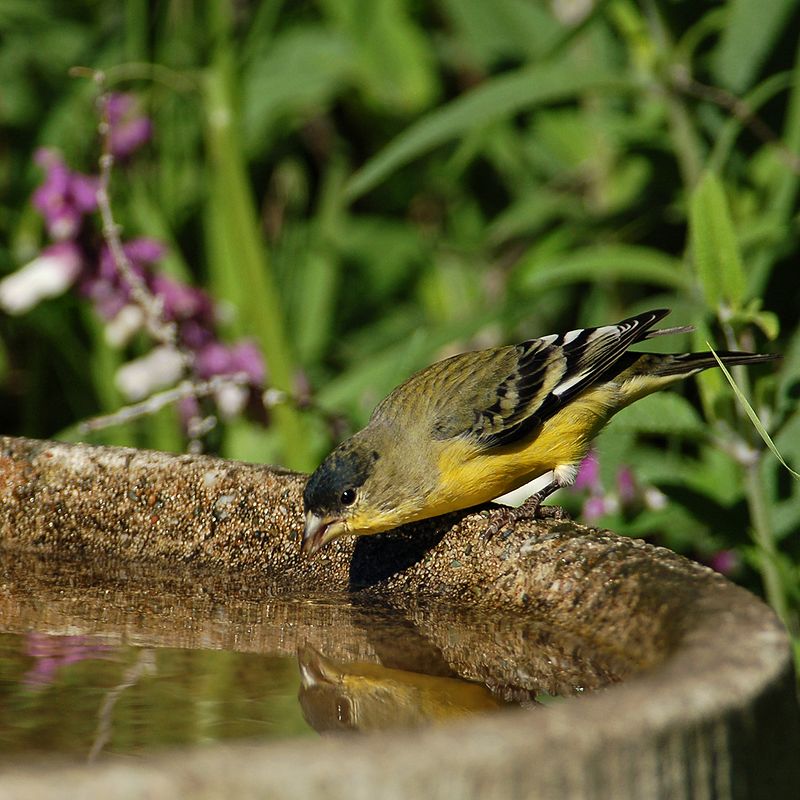
The Lesser Goldfinch is a tiny species of bird found in the Americas. It belongs to the same clade as American goldfinches and Lawrence’s goldfinches, which can be identified by their males having black or rarely green foreheads.
The face appears red or yellow on these birds, unlike other species in its genus Spinus sensu stricto.
They are small songbirds with short bills, brown wings and tails with white edges, grey-brown backs and olive heads.
These birds inhabit open woodlands and fields where they feed mainly on seeds from weeds such as thistle, pigweed, and ragweed but also consume insects at times during the breeding season for additional nutrition.
In addition to being an important part of North America’s avian ecology, these birds have been popularized through recent artwork depicting them in various poses among flowers.
Scientific classification:
| Kingdom | Animalia |
| Phylum | Chordata |
| Class | Aves |
| Order | Passeriformes |
| Family | Fringillidae |
| Subfamily | Carduelinae |
| Genus | Spinus |
| Species | S. psaltria |
Also Featured In: Top Birds Found in Mexico, Birds that Live in the Deserts
3. Willow Flycatcher
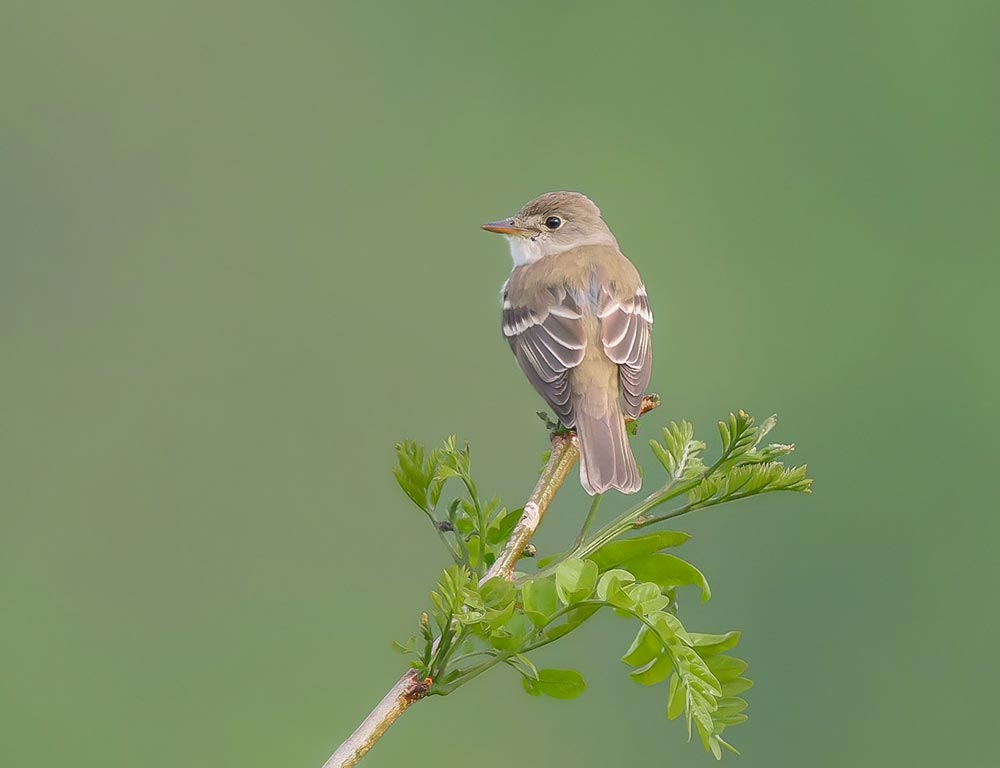
The Willow flycatcher is a small insect-eating bird belonging to the tyrant flycatcher family. It migrates from its neotropical home during summer months and breeds in North America, with three of its four subspecies found in California.
These birds can be difficult to identify by sight but their songs are distinctive enough for biologists to tell them apart easily.
The male willow flycatcher has an olive back, white underparts, and yellowish legs while females have duller colors overall such as grey on the head instead of olive green.
They prefer open woodlands or river edges where they feed mostly on insects like flies, beetles, and caterpillars which makes it beneficial for controlling pest populations near agricultural areas too.
Scientific classification:
| Kingdom | Animalia |
| Phylum | Chordata |
| Class | Aves |
| Order | Passeriformes |
| Family | Tyrannidae |
| Genus | Empidonax |
| Species | E. traillii |
Also Featured In: Flycatchers Species, Willows Birds Around You
4. Hammond’s Flycatcher
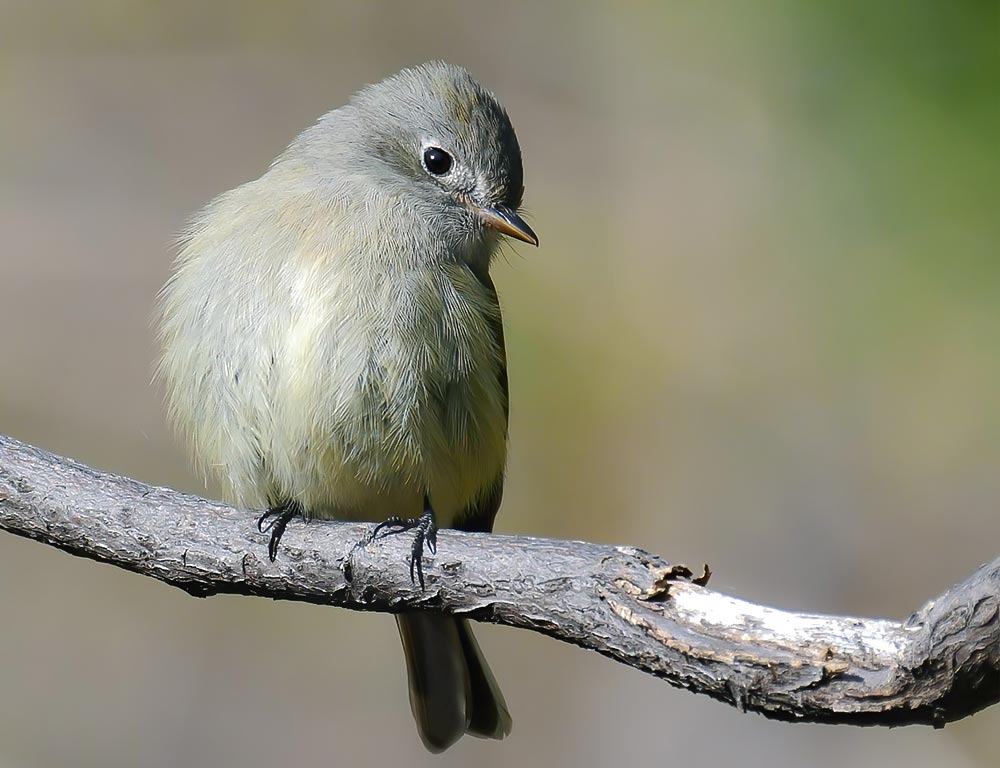
Hammond’s flycatcher is a small insectivorous bird found in the coniferous and mixed forests of Western North America.
It was named after William Alexander Hammond, who served as Surgeon General of the US Army and collected bird specimens for Spencer Fullerton Baird.
Adults measure between 12-14 cm long (4.7-5.5 inches) with a wingspan around 21cm (8 inches).
They have gray heads with yellowish eyestripe, olive backs, and whitish bellies; their tails are dark on top and lighter underneath but often barred by black feathers across it widthwise.
Males possess rusty red throats which can be seen when they sing from an open perch to advertise mating opportunities or defend territories against rival birds during breeding season – usually occurring April through May or June depending upon location.
Scientific classification:
| Kingdom | Animalia |
| Phylum | Chordata |
| Class | Aves |
| Order | Passeriformes |
| Family | Tyrannidae |
| Genus | Empidonax |
| Species | E. hammondii |
Also Featured In: Birds that Found in the Yellowstone , Most Common Birds in Michoacán
5. Black Phoebe
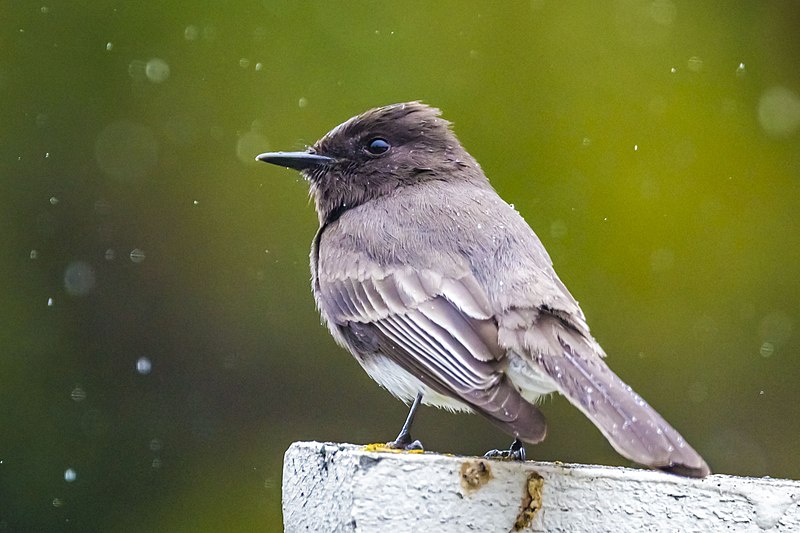
The black phoebe is a beautiful passerine bird belonging to the tyrant flycatcher family. It breeds from southwest Oregon and California south through Central and South America, where it can be found year-round.
However, its northern populations tend to migrate seasonally in some areas. Six subspecies of this species have been identified so far: two are occasional visitors while the others are more common residents in their range.
The adult has mainly dark grey upperparts with a white belly; juveniles may show brownish tones instead of grey ones on their back.
Its main diet consists of insects which it catches by hovering over water or flying out after them from perches near rivers or streams – hence why they’re often seen around these places.
Scientific classification:
| Kingdom | Animalia |
| Phylum | Chordata |
| Class | Aves |
| Order | Passeriformes |
| Family | Tyrannidae |
| Genus | Sayornis |
| Species | S. nigricans |
Also Featured In: Birds Live Near San Diego, Common Southern Californian Birds
6. Great Grey Owl
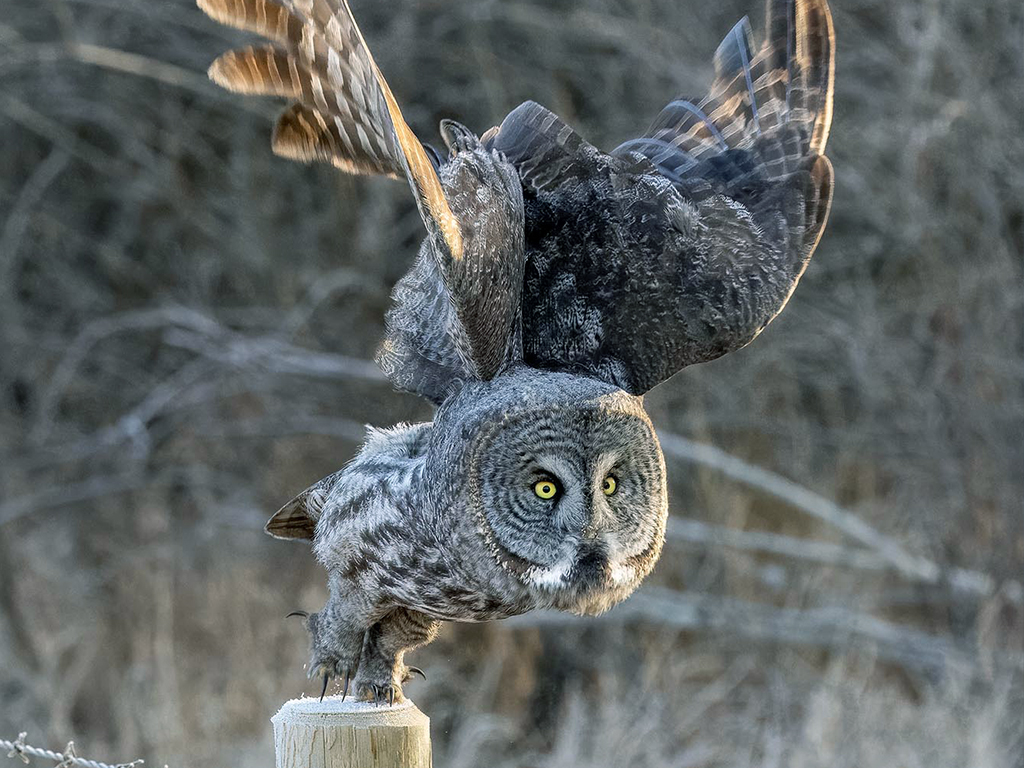
The Great Grey Owl is the world’s largest species of owl and is found across the Northern Hemisphere. It has many other names such as Phantom of The North, Cinereous Owl, Spectral Owl and Lapland Owl.
This majestic bird stands at an impressive length of about 24 inches with a wingspan that can reach up to five feet.
Its unique plumage allows it to blend in well with its natural environment which makes spotting this elusive creature quite difficult.
Despite being generally silent during most times, they are known for their deep hooting calls when mating or roosting season arrives.
These magnificent birds feed on small mammals like mice, voles, and hares but have also been seen hunting larger prey such as ducks and grouse depending upon availability in their area.
Scientific classification:
| Kingdom | Animalia |
| Phylum | Chordata |
| Class | Aves |
| Order | Strigiformes |
| Family | Strigidae |
| Genus | Strix |
| Species | S. nebulosa |
Also Featured In: Owls Species, Common Estonian Birds
7. Western Tanager
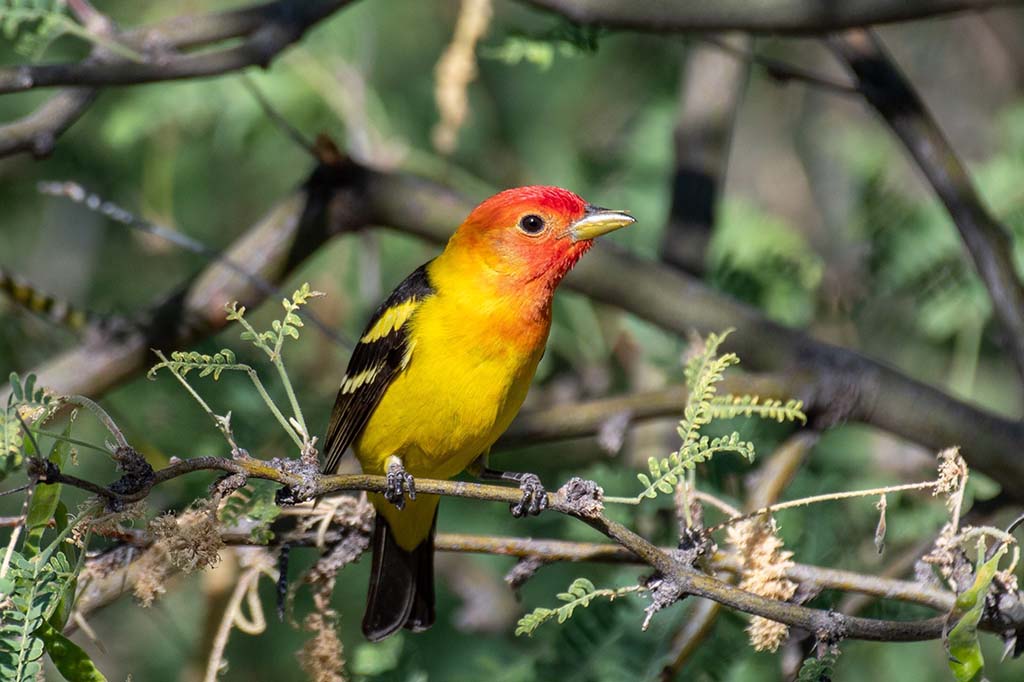
The Western Tanager (Piranga ludoviciana) is a medium-sized songbird belonging to the cardinal family, Cardinalidae. It was illustrated and formally described by American ornithologist Alexander Wilson in 1811.
The species has distinctive plumage including yellow feathers on its wings and tail, red shoulders, a black head with a white forehead patch, and grayish underparts.
Its vocalizations are also very similar to other members of the cardinal family – they have a high-pitched ‘tsee’ note followed by several sweeter notes that come together as parts of complex songs.
They primarily feed on fruit but will also take insects when available for extra protein during the breeding season.
These beautiful birds can be found throughout western North America from Alaska down through Mexico making them an iconic part of many landscapes.
Scientific classification:
| Kingdom | Animalia |
| Phylum | Chordata |
| Class | Aves |
| Order | Passeriformes |
| Family | Cardinalidae |
| Genus | Piranga |
| Species | P. ludoviciana |
Also Featured In: Utah Birds, Lake Tahoe Birds
8. Steller’s Jay
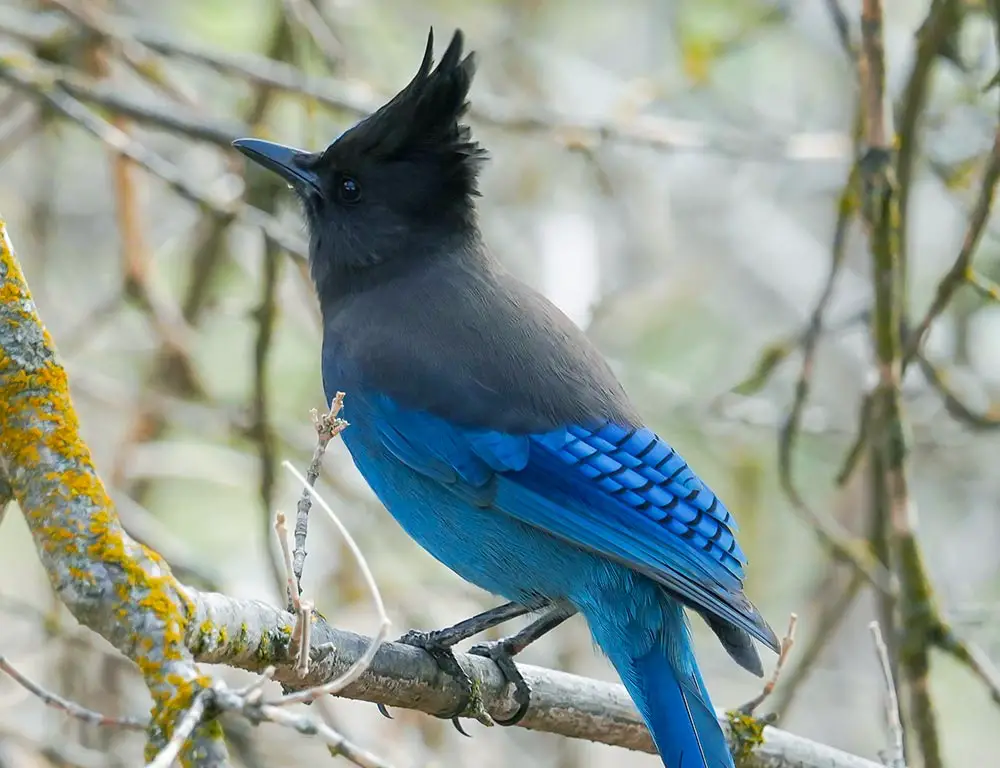
Steller’s jay is a beautiful and colorful bird native to western North America and the mountains of Central America.
It has a distinctive long crest that sets it apart from other birds, with its blue feathers streaked with black, white, gray, and brown markings.
This species is closely related to the blue jays found in eastern North America but can be distinguished by their longer crests.
They are known for being highly vocal birds who like to make loud calls throughout forests they inhabit as well as stealing food from unsuspecting mammals or raiding bird feeders when given the chance.
Steller’s Jays have adapted well to human presence in areas they populate making them great backyard visitors if you’re lucky enough.
Scientific classification:
| Kingdom | Animalia |
| Phylum | Chordata |
| Class | Aves |
| Order | Passeriformes |
| Family | Corvidae |
| Genus | Cyanocitta |
| Species | C. stelleri |
Also Featured In: Alaska Birds, Birds That Live in Colorado
To Recap
Yosemite National Park is a haven for bird enthusiasts, offering the opportunity to spot eight captivating bird species.
From the majestic Peregrine Falcon soaring above the cliffs to the charismatic Steller’s Jay perched in the pine trees, these birds contribute to the park’s natural beauty and ecological balance.
Their presence adds depth to the park’s biodiversity and provides visitors with a chance to connect with the wilderness through birdwatching.
By preserving their habitats and practicing responsible wildlife observation, we can ensure that these avian residents continue to thrive in Yosemite, reminding us of the park’s enduring role as a sanctuary for both nature and bird lovers alike.